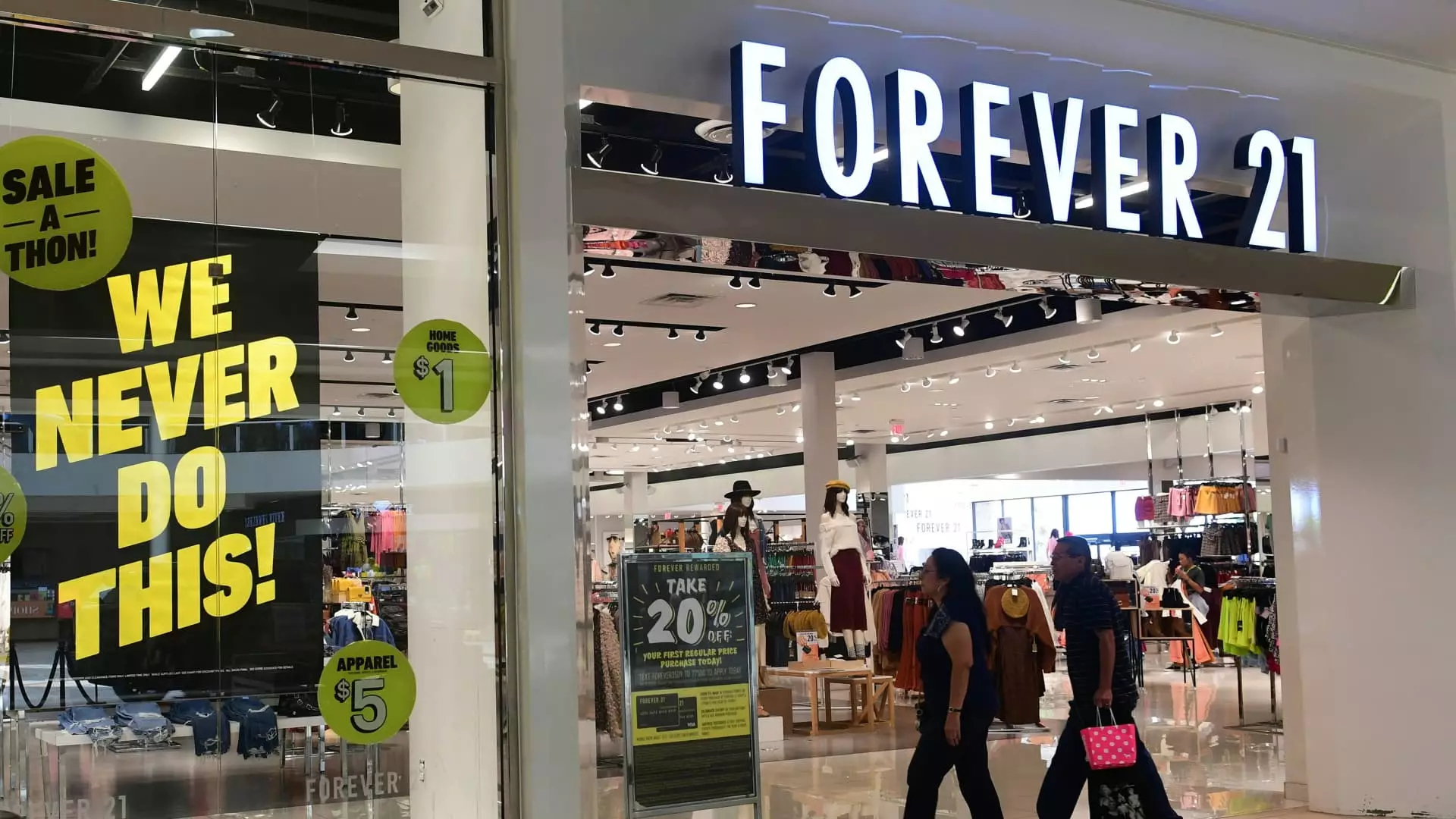The once-iconic fashion retailer Forever 21 is at a crossroads, grappling with financial distress and potential liquidation. As the fast fashion industry evolves, Forever 21’s struggles serve as reflective of broader trends affecting traditional brick-and-mortar retailers. With ongoing discussions about a possible second bankruptcy filing, the company faces a challenging reality that raises questions about its viability in an increasingly competitive market.
Reports indicate that Forever 21 is actively engaged with liquidators to explore its options, a clear indication of its precarious financial standing. Although the retailer initially sought buyers for its U.S. leases and assets in a bid to avoid extinction, the decision to consider liquidators is a sobering acknowledgment of the hurdles it faces. Potential buyers might be deterred not only by the company’s tarnished reputation but also by its inability to adapt to shifting consumer preferences and intensifying competition.
Formerly a leading player in the fast fashion arena, Forever 21 has recently watched its relevance diminish against rivals such as Shein and Temu. These online giants boast advanced technologies and flexible operational models that support rapid product turnover, allowing them to meet consumer demand more efficiently than traditional retailers. As Forever 21 searches for buyers or strategic partnerships, the question of whether any potential investor can successfully rejuvenate the brand looms large.
A complicating factor in Forever 21’s predicament is its ownership structure. The intellectual property (IP) of Forever 21 is under the stewardship of Authentic Brands Group, which operates separately from the retailer itself. This setup can create friction, as potential investors may be hesitant to engage with a brand whose intellectual property is not held directly by the business in question. Additionally, the current IP holders may be more focused on extracting value from the brand rather than investing the resources needed for a turnaround.
The partnership between Forever 21 and Shein, though initially promising, has yielded mixed results. While the collaboration presents opportunities for mutual growth, it can also complicate Forever 21’s independence and strategic direction. Shein’s recent stake in the Sparc Group, the firm managing Forever 21’s operations, further entangles these relationships and raises questions about future pathways for the retailer.
Internally, Forever 21 has been battling recurring issues, including profitability and inventory management. These challenges have been exacerbated by the broader economic climate, including rising tariffs and shifting consumer behavior post-pandemic. Once a trendsetter in the fast fashion space, Forever 21 has struggled to maintain its “cool factor,” with younger consumers increasingly favoring e-commerce platforms that are more agile and cost-effective.
In response to its escalating challenges, Forever 21 has made attempts to cut costs, including negotiating significant rent reductions with landlords. However, these measures alone may not be sufficient to rejuvenate its appeal or to stabilize its financial standing. As the economy shifts, the fallout from the pandemic has transformed consumer habits, favoring online shopping and convenience over traditional retail experiences.
Forever 21’s plight has significant implications for the retail sector as a whole. The challenges faced by the brand can be viewed as emblematic of a seismic shift in consumer shopping habits, where e-tailers are better equipped to cater to fast-changing trends. This situation mirrors past events when Amazon disrupted traditional retail, leaving countless brick-and-mortar stores in its wake.
As taxonomies within the fast fashion industry continue to evolve, industry observers are left to ponder the future role of traditional retailers. Brands that once thrived are now being forced to adapt rapidly, or risk being relegated to obscurity. Authentic Brands Group’s strategy of acquiring and potentially reviving struggling brands might become the norm in a landscape marked by volatility, but the success of such endeavors is far from guaranteed.
The immediate future of Forever 21 remains uncertain as it navigates critical discussions around potential liquidation or restructuring. While the option to liquidate could provide short-term financial relief by satisfying creditors, it raises the specter of the brand fading from the market altogether. Conversely, finding a strategic buyer who understands the intricacies of the fast fashion landscape could pave the way for a turnaround.
Despite the challenges ahead, the story of Forever 21 isn’t merely one of decline; it also reflects larger trends in consumer behavior and retail dynamics. Whether the company can adapt and resonate with a new generation of shoppers will determine its fate in a world where fast fashion’s definition is evolving rapidly. As discussions unfold, the industry’s eyes will be on Forever 21, hoping it can take the necessary steps to reclaim its position in the fashion world.


Leave a Reply